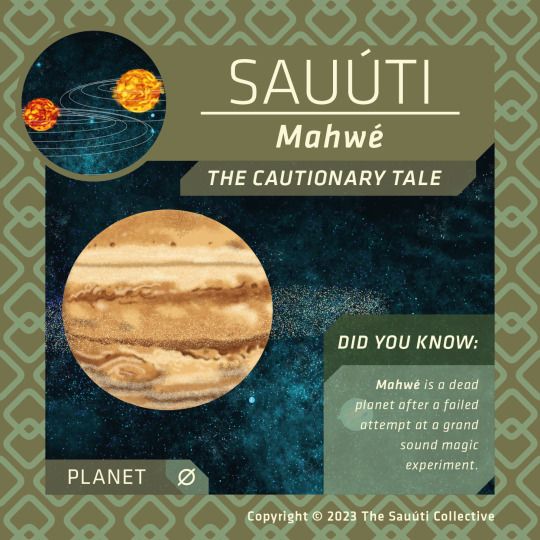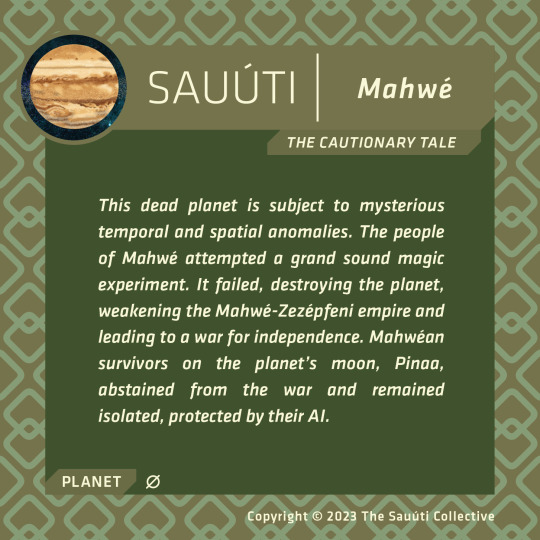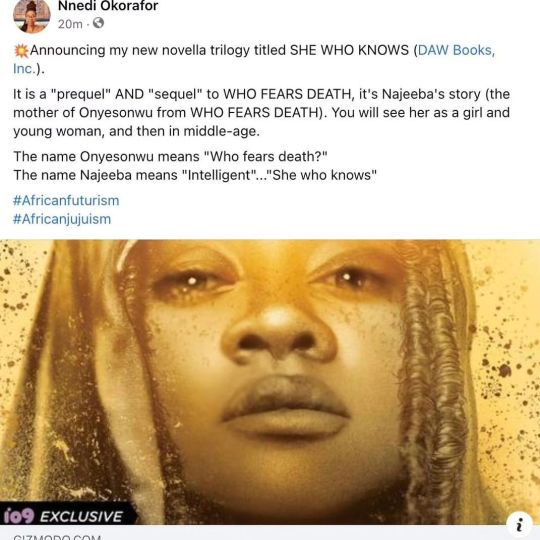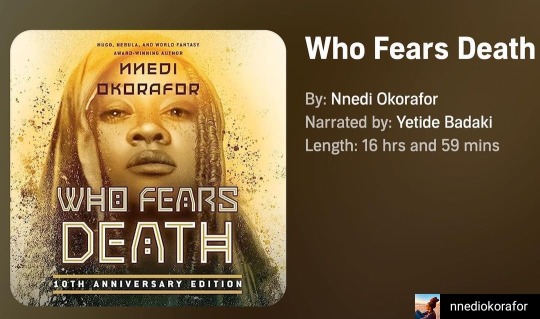#africanjujuism
Text
For black history month, I think we should begin popularizing monsters from the African continent the same way European monsters are overpopularized. To that end, here's a list of some of the most famous folkloric figures from Africa!
Mmoatia
Origin: Ghana (Akan)
Creature it is not: Dwarf
(Singular: Aboatia) Mmoatia are a subclass of abosom (spirits in between Man and Creator) that live in the forests of Ghana. They are short, have curved noses, backwards feet, and a unique language made up of only whistling sounds. Whistling in the forest is a sure way to get their attention. According to legend, they are phenomenal herbalists that will sometimes share their knowledge with humans. When a person gets lost in the woods, they are said to have been taken by Mmoatia. Humans who come back after being taken will become incredible medicine men. In Ghana, Dust Devils are called "Mmoatia Mframa" (Wind of Mmoatia) because they are belived to be a portal to their world similar to how fairyrings are treated in Ireland.
Mmoatia are divided into three tribes: Black, White, and Red. Black Mmoatia are supposedly harmless, while White and Red ones are always up to some kind of mischief.
Adze
Origin: Ghana (Ewe)
Creature it is not: Vampire
In Ewe culture, the Adze is a type of demonic spirit associated with witchcraft. They take the form of a fire fly that, during the night, crawls inside human beings in order to posses them. People possesd by the Adze are said to be witches, who use the spirit to slowly drain the life force of people that they envy (Old witches target the young, Poor witches target the wealthy, enslaved witches target their masters as they should).
When targeting a person, the Adze will leave it's host human during the night and crawl into the house of the victim. When it's close, it will drain blood from the victim like a mosquito.
Werehyena
Origin: Pan-African
Creature it is not: Werewolf
Just like how there are Werewolf stories all over Europe, there are Werehyena stories all over Africa. Compared to werewolves, which are said to be men cursed to be monsters, Werehyenas are actually monsters that disguise themselves as humans only to eat it's friends during the night. The people most likely to be werehyenas are village outsiders and blacksmiths, who are associated with magic.
In Angola, there is a similar (but not the same) creature to the werehyena called the Kishi. It is literally a two-faced demon that has a handsome man's body and face in the front, and a hyena's face in the back. This creature lures unsuspecting women into relationships so that it may eat them. If the Kishi has any male children with it's prey, it teaches them the art of femicide.
Mami Wata
Origin: Pan-African
Creature it is not: Mermaid (ok, it kinda is a mermaid but I need to keep the joke running)
Even more wide-spread than the Werehyena, Mami Wata is a figure so popular that it is common for water spirits in Africa to be retroactively labeld as Mami Wata and take on her iconography.
The most famous picture of Mami Wata is actually a french painting of a black Caribbean snake charmer, who west africans later identified as Her. Mami Wata is worshipped as a powerful, female river spirit that controls the flow of the river, the rate at which fish can be caught, the money that men can make, and several other things important to humanity. She is also said to be a seductress, who sleeps with unsuspecting men only to later kill them for cheating on their wives. Indeed, Mami Wata is a defender of women and a slayer of sinful and abusive men.
In many places, it is common to believe that women who drown or go missing in bodies of water were taken by Mami Wata to be taught magic. The women who return become pristessess to her, while the women who never come back become new Mami Watas.
Impundulu
Origin: South Africa (Zulu)
Creature it is not: Thunderbird (no hate, Thunderbird gets constantly thrown into things where it shouldn't be by people who don't understand it. And those people tend to be not native)
Impundulu, or Lightning Bird (NOT THUNDER BIRD), is a person sized Hamerkop bird that has the power to control the weather and summon lightning. It is also creature of evil magic, allied with witches and it has a never ending hunger for blood. It is said to sometimes take the form of a handsom young men in order to seduce women (why dose that keep happening).
Impundulu are immortal, and the ones that serve as witch familiars are passed down in the family as the old master dies and the child becomes grown. The bird is immune to gunshots, stabbing, drowning, and poison. It's only weakness is fire.
#black history month#west african mythology#west african folklore#african fairy#african fantasy#fantasy#africanjujuism#dnd#d&d#mmoatia#adze#werehyena#kishi#mami wata#impundulu#blackblr
22 notes
·
View notes
Text


𝙏𝙃𝙀 𝘾𝘼𝙐𝙏𝙄𝙊𝙉𝘼𝙍𝙔 𝙏𝘼𝙇𝙀: 𝙈𝙖𝙝𝙬𝙚́ (Planet)
This dead planet is subject to mysterious temporal and spatial anomalies. The people of Mahwé attempted a grand sound magic experiment. It failed, destroying the planet, weakening the Mahwé-Zezépfeni empire and leading to a war for independence. Mahwéan survivors on the planet’s moon, Pinaa, abstained from the war and remained isolated, protected by their AI.
𝘿𝙄𝘿 𝙔𝙊𝙐 𝙆𝙉𝙊𝙒: Mahwé is a dead planet after a failed attempt at a grand sound magic experiment.
📖👀🔥🚀🪐
Can we count on your pledge for this anthology?
Sign up to receive email notifications as soon as we launch the anthology crowdfunding:
Backer perks include:
* anthology author book bundles
* signed books by anthology authors
* tuckerizations (your name in a story)
* short story, novella, & comic edits
* Alternative cover art by Paul Lewin
* signed art
* video call with Sauúti Collective members
* and of course copies of Mothersound: The Sauútiverse Anthology
2 notes
·
View notes
Text

Writes Okorafor: “Afrofuturism: Wakanda builds its first outpost in Oakland, CA, USA. Africanfuturism: Wakanda builds its first outpost in a neighboring African country.” (via Afrofuturism, Africanfuturism, and the Language of Black Speculative Literature | Los Angeles Review of Books)
#Afrofuturism#Africanfuturism#scifi#future#imagination#fiction#speculative fiction#Black speculative fiction#white Western gaze#Nnedi Okorafor#Hope Wabuke#Black Speculative Literature#Africanjujuism#science fiction
2 notes
·
View notes
Photo

Did yall see the news? Nnedi Okorafor announced SHE WHO KNOWS, an upcoming prequel to Who Fears Death?!? Have you read Who Fears Death and Book of Phoenix? If not, we are in stock! Link in bio: @sistahscifi | www.sistahscifi.com | https://sistahscifi.com/search?type=product%2Carticle%2Cpage&q=Who+fears+death. Better yet, check it out from your local #library! Reposted @nnediokorafor 💥DAW Books has acquired North American rights and audio to three adult africanjujuist novellas by award-winning superstar Nnedi Okorafor: She Who Knows and two sequels. “I’ve wanted to write this story for over a decade,” Okorafor shared in an exclusive statement to io9. “It’s been dwelling in my head like a living storm. If you thought Onyesonwu from Who Fears Death was intense, wait until you truly meet her mother. Phew!” #nnediokorafor #nnedi #nnedimmankemdiliokorafor #nnedimma #SheWhoKnowsTrilogy #WhoFearsDeath #TheBookOfPhoenix #africanjujuism #africanfuturism #trilogy #novellas #sciencefiction #literature #africanliterature #sistahscifi @dawbooks (at Sistah Scifi) https://www.instagram.com/p/CpnMvoGrkQO/?igshid=NGJjMDIxMWI=
#library#nnediokorafor#nnedi#nnedimmankemdiliokorafor#nnedimma#shewhoknowstrilogy#whofearsdeath#thebookofphoenix#africanjujuism#africanfuturism#trilogy#novellas#sciencefiction#literature#africanliterature#sistahscifi
2 notes
·
View notes
Text
Nnedi Okorafor, (born April 8, 1974, Cincinnati, Ohio, U.S.), Nigerian American author whose science fiction and fantasy novels, short stories, and comics for both children and adults express her concepts of Africanfuturism and Africanjujuism. Okorafor often promotes young Black girls as superheroes in her work, and her writing investigates racial inequality, sexual violence, and other social issues.
11 notes
·
View notes
Text
Nnedi's Wahala Zone Blog: Africanfuturism Defined
Afrofuturism: Wakanda builds its first outpost in Oakland, CA, USA.
Africanfuturism: Wakanda builds its first outpost in a neighboring African country.
2 notes
·
View notes
Text
I must admit, the Silkpunk and Hopepunk sub-genres look very interesting.
0 notes
Video
Have you ever been so excited for a character that you ramble off on four different tangents? We certainly have, and it made for terrible podcasting so we rerecorded the bit. Trust us, clarity over sincerity. The full quote from Who Fears Death: “My cousin always talks about how only a pure woman attracts a man pure enough to bring pleasure to the marriage bed. She says her husband is the purest man around . . . probably because he was the first who didn’t bring her pain.” “Ugh,” Luyu said, angrily. “We’re tricked into thinking our husbands are gods.” You can find our episode discussing Who Fears Death here: -on our website: http://bit.ly/3oQPCdc -on @applepodcast: https://apple.co/3tv4txu -on @spotify: https://spoti.fi/3ru2O9P . . . #podcast #bookpodcast #whofearsdeath #nnediokorafor #bookrecommendations #africanfuturism #africanjujuism #goodreads #scifi #literature #fantasy #books #booklover #bibliophile #sff #fiction #bookstagram #fictionfans #fictionfanspodcast https://www.instagram.com/p/CLmnEa7Hg5V/?igshid=o2l22fb5u1le
#podcast#bookpodcast#whofearsdeath#nnediokorafor#bookrecommendations#africanfuturism#africanjujuism#goodreads#scifi#literature#fantasy#books#booklover#bibliophile#sff#fiction#bookstagram#fictionfans#fictionfanspodcast
0 notes
Text


𝘽𝙇𝘼𝙕𝙄𝙉𝙂 𝙈𝙊𝙏𝙃𝙀𝙍’𝙎 𝙒𝙍𝘼𝙏𝙃: 𝙅𝙪𝙖𝙝-𝙖̄𝙟𝙪 (Planet)
The Sauúti universe is a five-planet system orbiting a binary star: the two suns are called Zuúv’ah and Juah-āju. Juah-āju is the larger of the two stars. Orbited by the planets Órino-Rin and Ekwukwe.
𝘿𝙄𝘿 𝙔𝙊𝙐 𝙆𝙉𝙊𝙒: A juzu, the Sauúti “year”, is the time it takes Juah-āju and Zuúv’ah to complete one orbit around their common centre of mass. A standard ‘day’ is called a bés.
📖👀🔥🚀🪐☀️
Can we count on your pledge for this anthology?
Sign up to receive email notifications as soon as we launch the anthology crowdfunding:
Backer perks include:
* anthology author book bundles
* signed books by anthology authors
* tuckerizations (your name in a story)
* short story, novella, & comic edits
* Alternative cover art by Paul Lewin
* signed art
* video call with Sauúti Collective members
* and of course copies of Mothersound: The Sauútiverse Anthology
0 notes
Photo

Ancestral Voices: Esoteric African Knowledge opens up the discourse on why African spiritual systems remain demonized whilst other spiritual systems are revered the world over. Using comparative analyses, it explores tenets (ideas/concepts) found across the various religious and spiritual systems; including the Abrahamic Faiths, Hinduism and Buddhism, to show the vast areas of overlap and commonality that are largely ignored. It ultimately poses the question to the viewer that if they are so similar in framework and ideas, then what is the yardstick used to still maintain that African Spirituality is all evil and negative? It also covers the impact of the media and colonialism in presenting a distorted view of it that does not foster an accurate understanding or perception of it." www.ancestralvoices.co.uk/av1 #ancestralvoices #africanspirituality #esoteric #knowledge #ancestors #wisdom #religion #spirituality #vodou #voodoo #obeah #witchcraft #juju #africanjuju #demonized #faiths #faith #comparativereligion #okomfo https://www.instagram.com/p/Bw5BqrBnN1G/?utm_source=ig_tumblr_share&igshid=z3omydsr6x7v
#ancestralvoices#africanspirituality#esoteric#knowledge#ancestors#wisdom#religion#spirituality#vodou#voodoo#obeah#witchcraft#juju#africanjuju#demonized#faiths#faith#comparativereligion#okomfo
5 notes
·
View notes
Text

Yes!! Who else loves books read by Yetida Badaki!!!!!
Reposted @nnediokorafor The new audiobook of WHO FEARS DEATH is now available on @librofm. It’s read by @yetide (American Gods, This is Us, Rise).
It’s such a powerful reading. Yetide channels Onyesonwu so well!
Today, I also finished an ugly messy draft of the second book in the SHE WHO KNOWS novella series (which is about Onyesonwu’s mother Najeeba)!
This is my first time saying this publicly (my editor doesn’t even know I’ve been working on it). Now that the draft is out of my head, I can finally admit I’ve been working on it, 😆.
These books are set before and after WHO FEARS DEATH. It’s been surreal revisiting this world and characters. Phew.
The story keeps growing.
#nnediokorafor
#yetidebadaki
#africanjujuism
#africanfuturism
#speculativefiction
#whofearsdeath
#shewhoknows
#SistahScifi
2 notes
·
View notes
Text
Nnedi Okorafor and Africanfuturism

Nnedi Okorafor is a multi-talented and highly awarded Nigerian American author. She writes for both children and adults and is best known for her novels. Nnedi also coined the term “Africanfuturism” which she defines as distinct to Afro-futurism. On her personal blog she writes that she felt the need to coin the term because she thought that Afrofuturism had various definitions that did not fully fit her oeuvre of work. She also thought that this term was being assigned to her incorrectly and she wanted to regain control over how others defined her.
As Nnedi writes, “Africanfuturism is a sub-category of science fiction.” She also introduces the term Africanjujuism as a subcategory of fantasy that “respectfully acknowledges the seamless blend of true existing African spiritualities and cosmologies with the imaginative.”
Africanfuturism is similar to Afro-futurism in the sense that they both center black experiences and themes of science fiction. However, it is different in the sense that it takes place outside of the western perspective. African culture, history, and mythology are all salient in Africanfuturism. It’s vision of the future is also more interested in tech and is much more optimistic since it is focused more on the endless possibilities of the future. Themes of “what could have been” are a major part of Afrofuturism since there is a sense of stolen culture and identity for many African American people. Africanfuturism on the other hand acknowledges and accepts “what has been” and is more concerned with actively envisioning and shaping a better future.
In this piece I want to analyze Nnedi Okorafor’s short story “Spider the Artist'' and the way Africanfuturism makes the story distinct.
[Spoilers below the cut]


illustrations from the Finnish translation “Spider the Artist" published in the sf mag Tähtivaeltaja.
The story takes place in an alternate Nigeria where the country is being continuously depleted of its resources and the people are suffering as a direct result. Already we know this is an Africanfuturist story since it is set in Africa and is informed by Nigerian politics and legends. In this story, huge oil pipelines divide the land and they are guarded by dangerous android spiders referred to as “zombies.” They violently attack anyone who even comes in contact with the pipes. Eme lives here with her abusive husband with only her guitar as solace for her soul.
One day, as she is depressed and throwing caution to the wind, she sits near one of the pipes in her backyard and plays her guitar. The music draws a zombie to her who listens as she plays, initially with fear. The zombie does not harm her and often comes back to hear her play guitar. It even weaves its own instrument and plays along with her. Eme decides to name the zombie Udide Okwanka which means “Spider the artist.” The name comes from a Nigerian legend about the Supreme Artist, Udide, who takes fragments of things and transforms them into something new. As they bond over their shared love of music, Eme’s home life gets moderately better since her husband no longer beats her as a result of listening to the sweet music.
This small peace is disrupted when an oil pipeline bursts near the elementary school. It is an opportunity for the community to gather free fuel, especially since the zombies had yet to show up to repair the pipe. Eme’s husband rushes out to tell her the news and that is when he discovers her with Udide. He views this as her fraternizing with the enemy and leaves in disgust. Eme fears that the pipeline burst is a trap and goes to warn her husband. Dozens of people have gathered by the fountain of fuel and are taking as much fuel as they can when the zombies arrive. Eme tries to find Udide among them and she notices that two zombies are about to emit a spark to ignite the fuel. Eme is the sole survivor of the fire because Udide shielded her inside its force field. The story ends with Eme contemplating how she, Udide and her unborn daughter are now caught in the middle of a war between humans and zombies, and their only hope is that the zombies never learn how to cross oceans.
Even though the story is short it is packed with multiple themes to analyze. Right off the bat the audience is presented with domestic abuse and corruption of the Nigerian government. Okorafor made it a point to establish that the current resource crisis is a direct result of the government selling their oil to the big fuel companies like Shell and Chevron. They are responsible for the depletion of the forests and the pollution of their waterways as well as the creation of the zombies. These companies needed some way to protect their precious pipes from the people that they had impoverished. As a result, they created killing machines because they valued property and profit over human life. The response to this was a revolutionary movement called the Niger Delta People’s Movement, of which Eme’s husband is a member. They cut through the pipes and steal fuel as well as protest even though the government and companies are openly killing them off. These conditions are probably what lead Andrew, Eme’s husband, to abuse her. Domestic abuse happens to many different kinds of people in many different scenarios. A lot of the time abusers do not need a reason to be abusive, but the stressful environment depicted here is certainly not helping to make things better. It is shown that domestic abuse rises during times of great strain and it seems like in this community it is just a fact of life since Eme is not the only woman going through this.
In this environment of exploitation, of the land and the people, there are also moments of human connection. Eme recalls memories of her father who was able to unite people with his guitar playing and distract them momentarily from their plight. He taught her how to play guitar and she eventually surpassed his skills. The sharing of music created a bond between father and daughter as well as a healing salve to the rest of the community. When Eme plays the guitar her father gave her she feels herself start to heal. It is also this guitar that connects her to the zombie she later names Udide. Zombies seem to be sentient and they hate humans, but Udide can’t help but to be drawn to the music Eme creates. While the rest of Nigeria is engulfed in a Humans vs. Technology conflict, Eme and Udide are able to connect with each other due to their love of music. Udide’s relationship to Eme reminds me of Eme’s relationship to her father since they both found solace in the guitar and they were both able to surpass the skills of the person who introduced them to music. Here, music is portrayed as an escape either from a hatred of humans or from a bleak and draining existence. Music has the power to both heal and unite.
I think that is why I don’t think the ending is a tragic one even though it is a dramatic one. Okorafor leaves things open ended, but she doesn’t remove the possibility of hope. Udide was able to break away from the hatred of humans that was programmed into them thanks to its sentience and I think this provides hope that the conflict between humans and zombies could end. The zombies eventually collectively broke away from the purpose they were programmed with and stopped protecting the pipelines. If the zombies and humans realized they were both being exploited they could turn their efforts against their common enemy; the companies and government. Music was the bridge that united Eme and Udide. It formed a protective bond between them which means that it has the capacity to do the same for all the other zombies and humans. They have the ability to tug at the heartstrings of humans and zombies the same way they pluck their guitar strings. Even in the darkest of times people can always stop and listen to the music.
19 notes
·
View notes
Link
Africanfuturism is a sub-category of science fiction. Africanjujuism is a subcategory of fantasy that respectfully acknowledges the seamless blend of true existing African spiritualities and cosmologies with the imaginative.
[...]
Africanfuturism is similar to “Afrofuturism” in the way that blacks on the continent and in the Black Diaspora are all connected by blood, spirit, history and future. The difference is that Africanfuturism is specifically and more directly rooted in African culture, history, mythology and point-of-view as it then branches into the Black Diaspora, and it does not privilege or center the West.
Africanfuturism is concerned with visions of the future, is interested in technology, leaves the earth, skews optimistic, is centered on and predominantly written by people of African descent (black people) and it is rooted first and foremost in Africa. It's less concerned with "what could have been" and more concerned with "what is and can/will be". It acknowledges, grapples with and carries "what has been".
#africanfuturism#Nnedi Okorafor#afrofuturism#including that term as well as she describes how it differs from africanfuturism
2 notes
·
View notes
Text
Wer fürchtet den Tod von Nnedi Okorafor
Eine neue #Rezension! Wer fürchtet den Tod von Nnedi Okorafor aus dem Hause @crosscult ist schonungslos und packend
Wer fürchtet den Tod von Nnedi Okorafor
Ich folge Nnedi Okorafor schon seit geraumer Zeit auf twitter und bewundere sie für ihre scharfen Beobachtungen und ihre coole Art. Ihre Bücher klingen phantastisch und eröffnen mir neue Perspektiven, habe ich bisher hauptsächlich Bücher weißer Autor*innen gelesen. Umso mehr freute ich mich auf “Wer fürchtet den Tod”.
Anzeige
Autorin:Nnedi Okorafor,…
View On WordPress
#africanfuturism#africanjujuism#buchbesprechung#crosscult#dystopie#fantasy#nnedi#nnedi okorafor#onyesonwu#review#rezension#rezi#rezi wer fürchtet den tod#wer fürchtet den tod#who fears death
0 notes